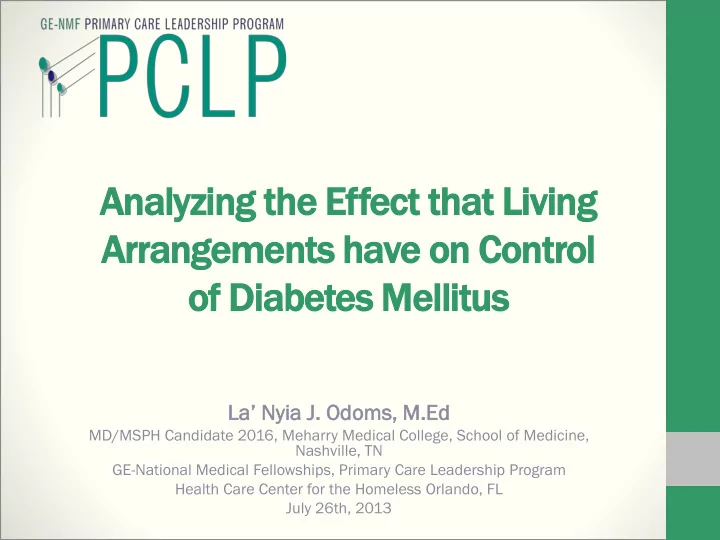

Analyzing the Eff ffect that Living Arrangements have on Control of Diabetes Mellitus La’ Nyia J. Od Odoms, , M.Ed MD/MSPH Candidate 2016, Meharry Medical College, School of Medicine, Nashville, TN GE-National Medical Fellowships, Primary Care Leadership Program Health Care Center for the Homeless Orlando, FL July 26th, 2013
Introduction Health th Care Center for the Homeles ess NCQA Patient-Centered Medical Home- Level 2 Celebrating 20 20yr yrs of service!
Background Why Diabetes…Living Arrangements…Research? Diabetes is a major cause of heart disease and stroke, and continues to be the leading cause of kidney failure, nontraumatic lower-extremity amputations, and blindness among adults, aged 20-74 (National Diabetes Fact Sheet, 2007). Homeless people suffer from significant levels of morbidity and mortality, but there is little evidence that homeless- ness has a direct adverse effect on health outcomes.
Research Objective • Analyze variance in hemoglobin A1C levels to improve glycemic control *Housing Status Gender Ethnicity Race
Methodology PRACTICE CTICE ANALYTIC TICS S SPSS SS -Frequency tables for demographics and -Obtained for demographics w/n demographics from two housing diabetic patients categories whose date of last visit was between -Independent Samples June 2011-May 2013 T- Tests for demographics and for demographics w/n - Recorded two housing hemoglobinA1C levels categories -Analysis of Variance (ANOVA) tests for race and for race w/n two housing categories
Results HOUSING STATUS Frequency Cumulative Percent Valid Percent Percent Valid Housed 434 78.2 78.2 78.2 Homeless 121 21.8 21.8 100.0 Total 555 100.0 100.0 Cumulative Frequency Percent Valid Percent Percent GENDER Valid Male 249 44.9 44.9 44.9 Female 306 55.1 55.1 100.0 Total 555 100.0 100.0 Cumulative Frequency Percent Valid Percent Percent ETHNICITY Valid Non-Hispanic 431 77.7 77.7 77.7 Hispanic 124 22.3 22.3 100.0 Total 555 100.0 100.0
Results Cont’d Cumulative Frequency Percent Valid Percent RACE Percent Valid Unknown 57 10.3 10.3 10.3 African American 274 49.4 49.4 59.6 93 16.8 16.8 76.4 White 56 10.1 10.1 86.5 Haitian Hispanic 63 11.4 11.4 97.8 Amer Indian 5 .9 .9 98.7 Asia 7 1.3 1.3 100.0 Total 555 100.0 100.0
Results Cont’d Mean Hemoglobin A1C Levels- Housing Status 12.00 11.00 10.00 8.73 8.40 9.00 8.00 Percent 7.00 6.00 5.00 4.00 3.00 2.00 1.00 0.00 Housed Homeless Mean difference NOT statistically significant (p = .136)
Results Cont’d Mean Hemoglobin A1C Levels- Gender 12.00 11.00 10.00 8.63 8.34 9.00 8.00 Percent 7.00 6.00 5.00 4.00 3.00 2.00 1.00 0.00 Female Male Mean difference NOT statistically significant (p = .128) Mean Hemoglobin A1C Levels- Gender 12.00 11.00 10.00 8.76 8.70 8.58 8.27 9.00 Housed 8.00 Homeless Percent 7.00 6.00 5.00 4.00 3.00 2.00 1.00 0.00 Female Female Male Male Mean differences were NOT statistically significant (p = .143 housed/ p= .898 homeless)
Results Cont’d Mean Hemoglobin A1C Levels- Ethnicity 12.00 11.00 10.00 8.54 8.24 9.00 8.00 Percent 7.00 6.00 5.00 4.00 3.00 2.00 1.00 0.00 Hispanic Non-Hispanic Mean difference was NOT statistically significant (p = .175) Mean Hemoglobin A1C Levels- Ethnicity 12.00 11.00 10.00 8.80 8.46 8.43 9.00 8.20 Housed 8.00 Percent 7.00 Homeless 6.00 5.00 4.00 3.00 2.00 1.00 0.00 Hispanic Hispanic Non-Hispanic Non-Hispanic Mean differences were NOT statistically significant (p = .275 housed/ p= .498 homeless)
Results Cont’d Mean Hemoglobin A1C Levels- Race 12.00 11.00 10.00 8.68 9.00 8.35 8.29 8.16 8.00 7.00 Percent 6.00 5.00 4.00 3.00 2.00 1.00 0.00 African American White Haitian Hispanic Mean difference was NOT statistically significant (p = .172)
Results Cont’d Mean Hemoglobin A1C Levels- Race 12.00 11.00 10.00 8.69 8.67 8.64 9.00 7.97 Housed 8.00 Percent 7.00 Homeless 6.00 5.00 4.00 3.00 2.00 1.00 0.00 African American African American White White Mean difference was NOT statistically significant (p = .063 housed/ p= .759 homeless) Mean Hemoglobin A1C Levels- Race 12.00 11.00 9.50 9.23 10.00 8.25 9.00 8.13 Housed 8.00 Percent 7.00 Homeless 6.00 5.00 4.00 3.00 2.00 1.00 0.00 Haitian Haitian Hispanic Hispanic Mean differences were NOT statistically significant (p = .063 housed/ p= .759 homeless)
Discussion No statistically significant difference in mean hemoglobin A1C between homeless and housed patients, nor across gender, race, and ethnicity. When homeless and housed (housing status) were used as categorical controls, no statistically significant difference was found between the aforementioned demographics. Data Collection: Quest Diagnostics vs. Florida Hospital Endocrinology Referrals Access to services at main clinical site Promising Diabetic Profile
Acknowledgements Dr. Cadet, Medical Director/Site Advisor Dr. Oliveira, Assistant Professor/Faculty Advisor Mehrin Islam, Former AmeriCorps Intern Mrs. Mariella Torrellas, Physician Assistant Mr. Bakari Burns, CEO Dr. Chianta Lindsey, Nurse Practitioner Dr. Chen, Assistant Professor, Meharry Medical College Dr. Brown, Assistant Professor/Advisor, Meharry Medical College GE-NMF Primary Care Leadership Program Health Care Center for the Homeless Staff & Patients
Questions/Comments
Recommend
More recommend